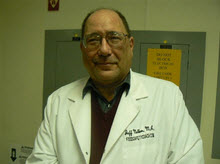No one, including crack restaurant inspector Jeff Nelken, likes looking under refrigerators for yesterday's forgotten dirt, filth and food particles shoved underneath by busy feet. He does it religiously, though, two or three times a day, 300 days a year. Like every food safety inspector, Nelken has horror stories that could make listeners' toes curl. But his proudest tales are of bringing a filthy restaurant back from the dead or helping a five-star restaurant avoid a failing grade or "closed" sign in its window.
Nelken is a premier food safety coach. He has invented a Five Star Inspection Program. This fast, thorough process helps his clients learn to use self-inspection as a path to self-reliance. He believes that too many owners rely solely on third-party auditors and health department inspectors to do their jobs for them. A better way, he advises, is to build food safety and pride into every restaurant activity.
Star 1: Assign Responsibility. Designate responsibility to one person for ensuring that everyone is trained in the same way. This is probably the most important job in the restaurant. This person must assign tasks, train, monitor and correct.
The goals are simple:
- Put the operation back into your hands.
- Recognize and reward your staff for achievement.
- Set standards for food safety performance.
- Teach the staff how to tell the difference between good and bad practices.
- Improve quality and reduce waste.
- Handle complaints and crises immediately.
Arm your internal inspector with the proper tools. Nelken recommends a flashlight, thermocouple, monitoring forms and sanitizer test strips. "We also suggest that the designated onsite person and the owner/ manager perform a thorough review of a variety of reports," says Nelken. "They will tell you a lot about what's right and wrong with your place of business." He suggests reviewing the following from a six-month period:
- health department inspection reports
- pest control inspection reports
- workers' compensation claims
- accident reports
- customer complaints.
Star 2: Train Staff Thoroughly. "As a prime example of poor training, we often find that food handlers don't even know why, when or how they are supposed to double-wash their hands after using the restroom," says
Nelken. "Even if the bathroom sports a sign that food handlers need to wash their hands after using the restroom, this is an easy one to skip, especially if it is not emphasized in the company's culture."
Basic training should include the following to fulfill Star 2:
- hand washing: how and when
- food handling basics
- receiving and storage
- cross contamination
- cleaning food to make it safe
- holding food to make it safe
- using the cold and hot tables
- serving food safely
- cleanup
- dish-and pot-washing
- chemicals, sanitizers and test strips
- foods to go
- party safety
- food allergy awareness
- understanding health department inspections.
Star 3: Control Time and Temperature. "We find that the biggest stumbling blocks to a good inspection report are time and temperature controls," Nelken says. "This is a frustrating but achievable goal that must be watched as closely as your reputation." The number-one cause of foodborne illness is improper cooling of hot food, which can cause as many as half of all illnesses.
Star 4: Screen Deliveries. The kitchen staff must know how to screen deliveries. Sometimes, however, teaching that skill can be difficult.
"We find that more and more workers speak English as a second language," Nelken says. "While this might have been common only in New York, California and Texas some years ago, it is not uncommon in all 50 states these days." This makes the job even more difficult, but discussing, monitoring and repeatedly reviewing inspection criteria help make it easier.
One of the most important steps in ensuring a clean, safe restaurant is knowing when to reject food.
Certain critical but frequently overlooked signs suggest that food being delivered to your restaurant does not pass muster. Nelsen suggests teaching your staff that anyone allowing substandard food to be delivered will be subject to disciplinary action-it's that serious. He advises rejecting deliveries under these conditions:
- Frozen food has thawed.
- Expiration dates have passed.
- Packaging is not intact.
- Food received is above 45°F (check your local jurisdiction).
- Food and chemicals are mixed together in the same delivery.
- Delivery trucks has signs of roaches, flies or rodent feces.
Star 5: Be Aware of Potential Dangers. Know your potentially hazardous foods (PHFs). Teach your employees that extra care must be taken with these foods to avoid a poor inspection or sick patrons.
"We have seen a rise in foodborne illnesses from foods that used to be unlikely culprits, like lettuce, green onions and shellfish. If you have a sick employee, any food could be fair game," Nelken says.
The most common PHFs are:
- cut melons
- sprouts eggs
- dairy and juices (pasteurized only)
- poultry
- meat, seafood, tofu
- cooked vegetables, rice, beans, pasta and potatoes
- garlic, onions and herbs in oil
- creamy pastries and cakes.
Take time to educate your staff about these PHFs and post this list as a reminder.
"So there you have it," says Nelken. "The Five Star Inspection Program is a big nut to chew, but once it has been learned, rehearsed and monitored, you will never have to feel apprehensive about inspections again."
Nelken added that there is quite a bit of buzz currently about the potential for bioterrorism sabotage at self-service stations in restaurants. "Unfortunately, we might have to add a sixth star in the future to address this issue," he says.
9 quick tips to a better inspection grade
- Use a minimum bare hand contact rule that requires disposable gloves and a strict hand washing policy for ready-to-eat foods.
- Have a written policy that is monitored daily for workers who have cuts or illnesses.
- Invest in a certified food handler program.
- Assist your chef and manager once a week during the inspection.
- Create a food safety committee that meets monthly to review and improve the operation.
- Correct health department violations ASAP. Buy only from approved vendors.
- Establish and document training and MSDS programs.
- Quiz staff weekly about safety topics.
- Share health department inspection reports with all employees.
Jeff Nelken, MA, retired RD is a Food Safety / HACCP Expert with 35 years experience in the hospitality industry. He specializes in Food Safety, Accident Prevention, Inspections, Audits and Training. Mr. Nelken is a certified trainer and provider with the Los Angeles Health Department who has worked with CNN, FOX, CBS, NBC, INSIDE EDITION, and Dateline MSNBC's investigation team, as well as Restaurants, Casinos, Schools, Supermarkets, and Food Manufacturers to provide food safety.
©Copyright - All Rights Reserved
DO NOT REPRODUCE WITHOUT WRITTEN PERMISSION BY AUTHOR.









